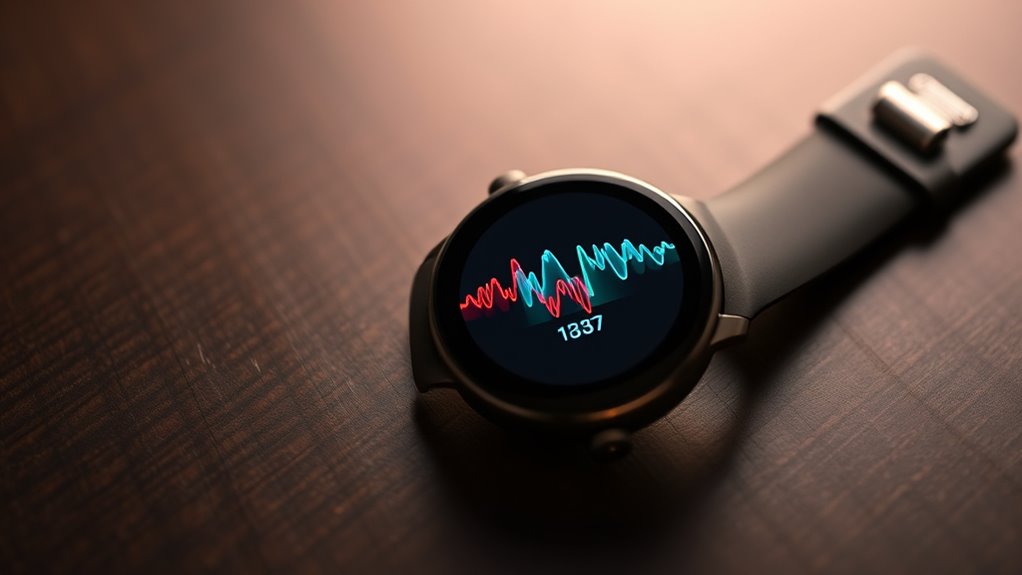Heart rate variability (HRV) measures how your autonomic nervous system responds to stress and relaxation by analyzing the time between your heartbeats. Higher HRV indicates a more adaptable, resilient body, while lower HRV suggests increased stress or fatigue. Monitoring HRV helps you understand your stress levels and overall health, with lifestyle factors like sleep and exercise influencing it. Keep exploring to learn how you can use HRV data to better manage stress and improve well-being.
Key Takeaways
- Heart Rate Variability (HRV) measures the variation in time between heartbeats, indicating stress resilience and nervous system health.
- Higher HRV reflects a balanced parasympathetic response, signaling relaxation and effective stress recovery.
- Lower HRV suggests sympathetic dominance, often associated with stress, fatigue, and emotional tension.
- HRV monitoring helps identify how daily stressors impact the body’s autonomic response.
- Lifestyle factors such as sleep, exercise, and stress management techniques influence HRV levels and stress adaptation.
What Is Heart Rate Variability and Why It Matters
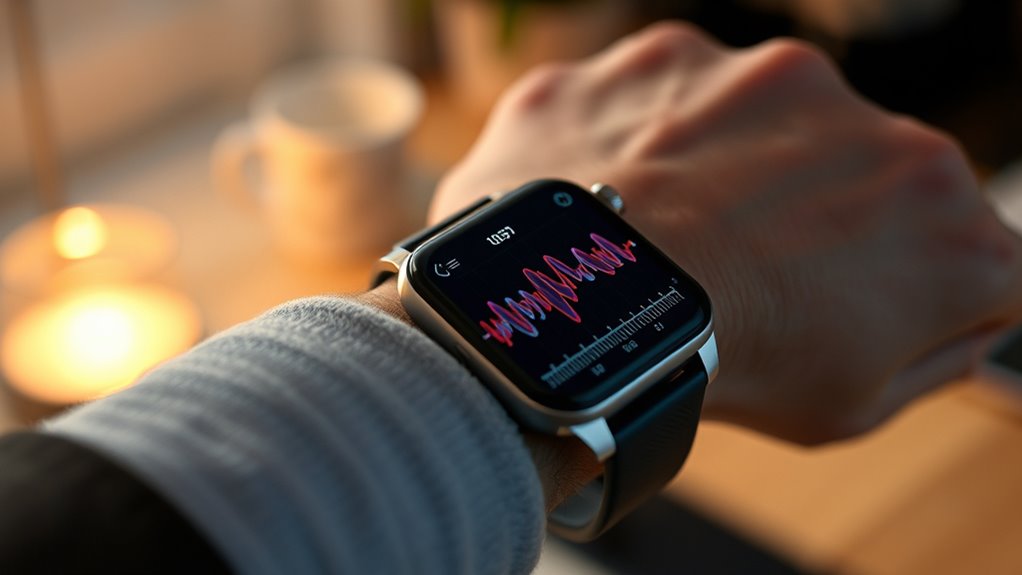
Heart Rate Variability (HRV) is a measure of the time between your heartbeats, usually expressed in milliseconds. It reflects how well your autonomic nervous system manages your heart, balancing sympathetic activity (fight-or-flight) and parasympathetic activity (rest-and-digest). High refresh rates enhance your understanding of rapid changes in heart rate, providing more detailed insights into your autonomic function. Higher HRV shows your nervous system is responsive and adaptable, which typically indicates better cardiovascular health and greater stress resilience. When your HRV is high, your body recovers more efficiently from physical or emotional stress, supporting overall well-being. Regular use of heart rate monitors can help you track these variations and better understand your body’s response to daily activities. Additionally, autonomic nervous system balance plays a crucial role in maintaining overall health and resilience to stress. Monitoring HRV can also alert you to potential health issues before symptoms become apparent, allowing for early intervention. Conversely, low HRV can signal increased stress levels and reduced recovery capacity. By tracking HRV, you gain insights into your body’s stress response and resilience, helping you understand your heart’s health and your ability to handle daily challenges.
How the Autonomic Nervous System Regulates HRV

The autonomic nervous system (ANS) plays a central role in regulating heart rate variability by coordinating the activity of its two main branches: the sympathetic and parasympathetic nervous systems. When your parasympathetic nervous system, mainly through the vagus nerve, activates, it promotes relaxation and increases HRV, signaling your body to rest and recover. Conversely, during stress or physical exertion, the sympathetic nervous system triggers the fight-or-flight response, decreasing HRV and causing heart rate fluctuations to become more uniform. Neural regulation from the hypothalamus processes sensory information and signals the ANS to adjust heart rate accordingly. Special Occasions The balance between these branches is crucial for maintaining overall health and resilience to stress. Understanding the social determinants of health can also influence HRV, as factors like social support and socioeconomic status impact stress levels and recovery. Additionally, advances in AI-driven health monitoring are enabling more precise assessments of autonomic function and stress resilience. This dynamic interplay between the sympathetic and parasympathetic branches determines HRV levels, reflecting your body’s overall stress response and recovery state.
The Relationship Between HRV and Stress Levels
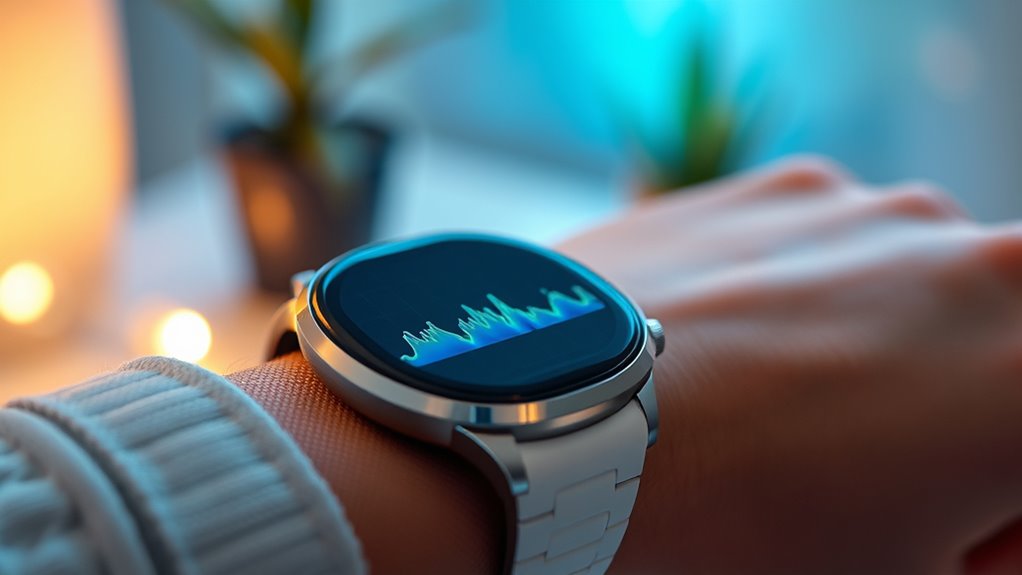
Your HRV levels can reveal how your body responds to stress, with lower HRV often signaling increased tension and sympathetic dominance. A well-balanced HRV reflects good health and resilience, whereas persistent low HRV may indicate vetted – Mother Baby Kids concerns such as stress or fatigue. When you’re under acute stress, your HRV drops as your body shifts into fight-or-flight mode, while chronic stress keeps HRV low over time. Conversely, higher HRV indicates relaxation and better resilience, showing your parasympathetic system is active and helping you recover. Recognizing these patterns can help you better understand your stress response mechanisms, enabling targeted interventions. Incorporating mindfulness practices can help improve HRV by promoting relaxation and reducing stress levels. Understanding heart rate variability as a comprehensive stress metric can further enhance your awareness of your body’s responses and resilience, especially since proper storage of essential oils can support overall well-being.
HRV Reflects Stress Response
When you experience stress, your autonomic nervous system shifts toward sympathetic dominance, causing HRV to drop. This decrease in heart rate variability reflects your body’s immediate stress response, as the sympathetic nervous system takes charge and parasympathetic activity diminishes. Ethical hacking techniques often simulate stress tests on systems to evaluate resilience and defenses. A lower HRV signals heightened stress and an autonomic nervous system imbalance, reducing your stress resilience. Acute stressors provoke quick HRV decreases, offering real-time insight into your body’s reaction. Conversely, as stress passes, HRV typically normalizes, indicating recovery. However, prolonged exposure to stress results in chronic stress, maintaining low HRV levels over time and signaling ongoing autonomic imbalance. Monitoring HRV helps you understand how your body responds to stressors, providing valuable feedback on your ability to adapt and recover from daily stress. Additionally, consistent HRV tracking can assist in identifying patterns that contribute to autonomic nervous system imbalance, enabling proactive stress management. Recognizing these patterns can also help inform your broader retirement planning strategies by highlighting areas where stress impacts your overall well-being. Furthermore, understanding the connection between HRV and natural techniques for stress reduction can empower you to adopt healthier coping mechanisms.
Low HRV Indicates Tension
Low HRV is a clear sign that your body is experiencing tension or heightened stress. When your stress levels rise, the autonomic nervous system shifts toward the sympathetic nervous system, activating the fight-or-flight response.
This physiological response causes your heart rate to stay elevated, reducing heart rate variability. A consistently low HRV indicates your body remains in this tense state, making it harder to relax and recover.
Chronic stress can sustain low HRV, impairing your ability to adapt to new stressors. Basically, low HRV reflects a dominance of the sympathetic nervous system, signaling ongoing tension. Louisiana Civil Code guidelines also influence how stress can impact legal processes like divorce, especially when it involves emotional strain.
Recognizing this pattern helps you understand how stress impacts your body, highlighting the importance of relaxation for restoring balance and promoting overall well-being. Incorporating techniques to improve heart rate variability can enhance your resilience to stress and support better health, especially when combined with stress management strategies backed by research.
High HRV Signals Relaxation
High HRV is a clear indicator that your body has shifted into a state of relaxation, with the parasympathetic nervous system taking charge. When this happens, your heart rate variability increases, signaling a calm physiological state and effective stress recovery. Fresh lemon juice typically lasts 2-3 days in the fridge, and spoilage signs include off-smell, discoloration, and separation. Elevated HRV levels are linked to greater emotional resilience and better stress management. You can promote high HRV through relaxation techniques like meditation and deep breathing, which help enhance autonomic balance. Here are 3 key points: 1. High HRV reflects a dominant parasympathetic nervous system and relaxation. 2. Increased heart rate variability indicates effective stress recovery and emotional resilience. 3. Consistently high HRV suggests a well-regulated body capable of handling stressors efficiently, supported by the benefits of airless paint sprayers that reduce physical strain during painting tasks. Additionally, understanding regulatory frameworks can contribute to overall stress reduction and financial well-being.
Methods for Measuring Heart Rate Variability
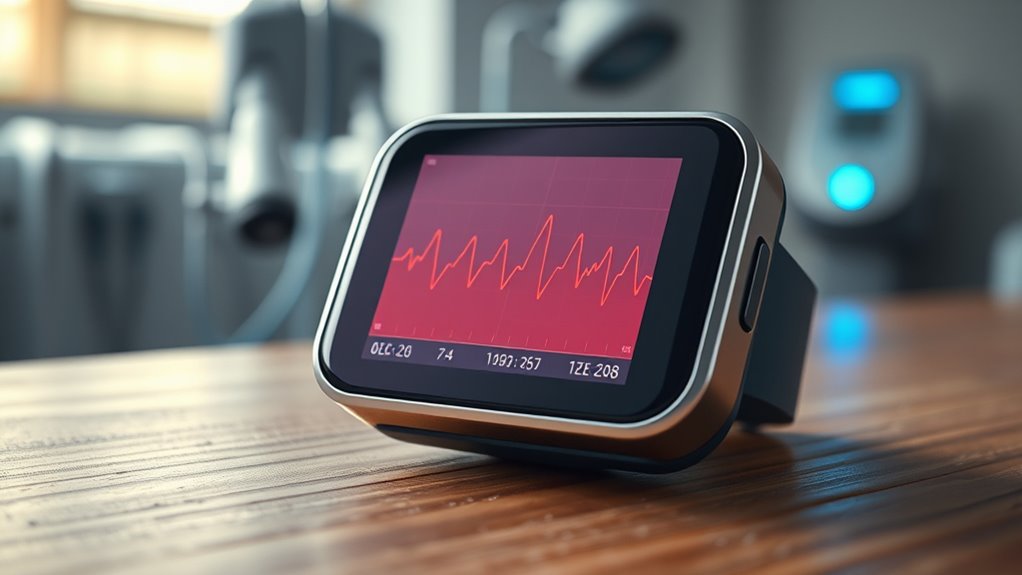
Measuring heart rate variability (HRV) involves analyzing the time intervals between your heartbeats, known as RR intervals. The gold standard is a long ECG performed in a medical setting, offering highly accurate data. For everyday use, wearable devices like chest strap monitors and wrist monitors track HRV by detecting beat-to-beat RR intervals. Chest straps generally provide more accurate HRV measurements, especially during physical activity. Consumer devices, including smartwatches and fitness apps, estimate HRV by analyzing RR intervals and calculating metrics like RMSSD, a common measure of heart rate variability. While these devices are convenient, their accuracy can vary. To get the most precise data, especially for medical insights, an ECG remains the most reliable method, but wearable devices offer practical alternatives for monitoring your HRV regularly. Understanding air purifiers can help improve indoor air quality, which may also influence your overall health and stress levels.
Factors That Influence HRV and Its Normal Range
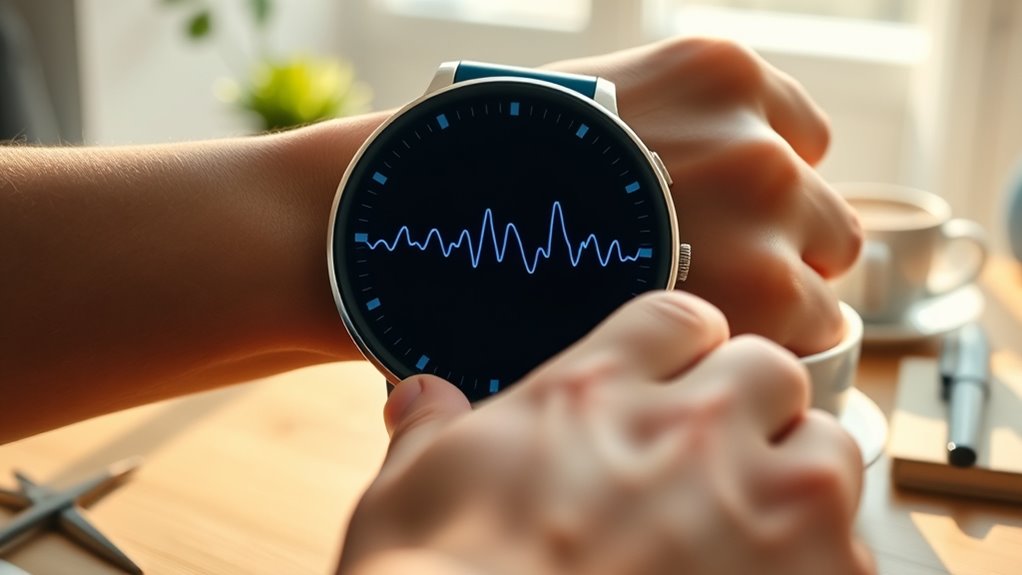
Various factors can influence your heart rate variability (HRV) and determine what’s considered a normal range. These factors affecting HRV include age, health conditions, lifestyle choices, and physical activity.
For example:
- Age and HRV: HRV peaks around age 15 and declines after 40, reflecting changes in the autonomic nervous system.
- Stress and health conditions: Chronic stress, heart disease, diabetes, and respiratory illnesses tend to lower HRV, indicating autonomic imbalance.
- Lifestyle factors: Sleep quality, diet, alcohol, smoking, and regular exercise all impact HRV levels. Good habits can enhance HRV, while negative habits decrease it.
Understanding these factors helps interpret your HRV measurement and its significance within the normal HRV range.
Using HRV Data to Track Stress and Improve Well-Being
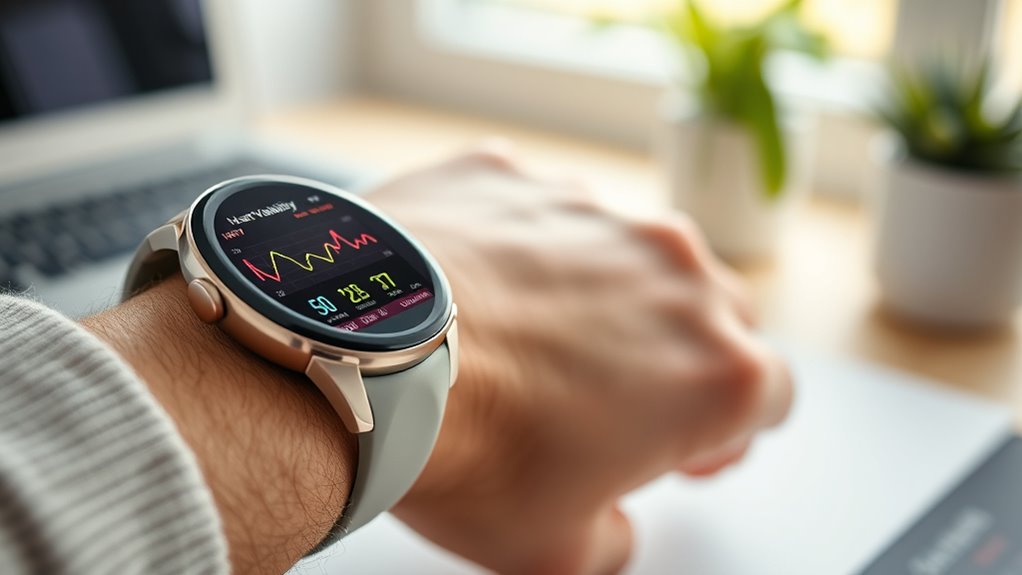
By tracking your HRV data regularly, you can gain valuable insights into your body’s response to stress and overall resilience. Heart rate variability, or HRV, reveals fluctuations in your autonomic nervous system activity, with lower HRV indicating higher stress levels and less resilience.
Monitoring HRV trends over time helps you see how daily stressors and lifestyle choices impact your well-being. Consistently low HRV readings may signal chronic stress or fatigue, prompting you to adopt targeted stress management techniques like deep breathing, meditation, or better sleep.
Frequently Asked Questions
What Is a Good HRV Stress Score?
You’re wondering what makes a good HRV stress score. Generally, a higher score indicates better stress resilience and a well-balanced nervous system. It reflects more parasympathetic activity, meaning you’re better at managing stress.
While an ideal score varies between individuals, aim for values above your baseline and consistent levels over time. Monitoring these scores helps you identify stress peaks and adjust your habits for improved overall well-being.
How Does Heart Rate Variability Measure Stress?
Imagine your heart’s rhythm as a lively dance—when stress hits, the dance slows, and the beats fall into a rigid pattern.
Heart Rate Variability measures this dance, tracking the tiny changes between beats.
When you’re stressed, the dance becomes stiff, indicating the sympathetic nervous system dominates.
As calm returns, the dance resumes its lively pace, revealing how your body responds to stress and recovers over time.
Should I Be Worried About a Low HRV?
You’re wondering if a low HRV should worry you. It’s normal to have occasional dips, especially after stress, poor sleep, or intense exercise.
However, if your HRV stays low over time, it might be a sign to review your lifestyle or consult a healthcare professional.
Keep tracking your trends, and don’t panic over a single reading. Focus on overall patterns to understand what your body’s telling you.
Is a HRV of 20 Bad?
Is a HRV of 20 really bad? Not necessarily, but it’s on the low end, which could mean your body’s under stress or not recovering well.
You might feel fatigued or overtrained. Think about your lifestyle—are you getting enough rest and managing stress?
Keep an eye on this number along with other health signs, and consider making adjustments to improve your autonomic balance and overall resilience.
Conclusion
Think of your heart rate variability as a delicate dance between stress and calm, shaping your overall well-being. When you tune into this rhythm, you’re guiding a symphony inside—each beat a note that reveals your body’s inner balance. By understanding and tracking HRV, you hold the baton to reduce chaos and restore harmony. Embrace this awareness, and you’ll orchestrate a healthier, more resilient version of yourself amid life’s unpredictable tempo.
